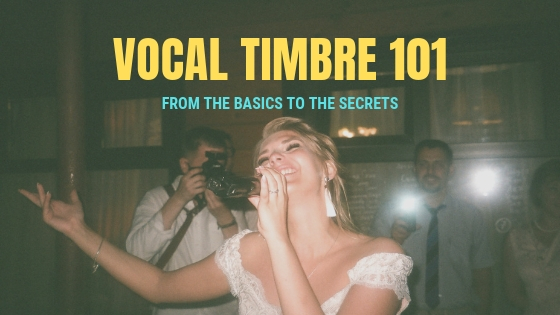Learning About Vocal Timbre
We all have an individual vocal timbre or tone quality that remains distinctive throughout our lives. For example, even though we may not have heard from a friend for many years, we will immediately recognize him by his voice, if he unexpectedly calls us by telephone. Unlike the voice, our external features will change with the years until they become difficult to recognize. Imitators, on the other hand, are skilled at changing their vocal timbre to sound like other people.
How does a voice imitator recall his own timbre? The vocal timbre is the result of the genetically inherited structure of the vocal organ and of the influence of the home environment.
After the act of imitating someone else, the imitator´s basic timbre will soon be restored to “factory settings”. The vocal timbre is of crucial importance for a singer to succeed.”Some people are born singers with a sonorous voice, others are not”, as Kim Borg once said to a student. The vocal timbre can, with appropriate practice, be improved to come under one´s control, although to a great extent it reflects occasional emotional, hormonal and other factors affecting the body.
There can hardly be a voice ugly enough that its timbre could not be improved to a bearable quality by practice. A good singer is able to vary the vocal timbre at will to reflect the lyrics and the music. There are no methods to “train an ability”, in fact, methods are neither to be recommended in most other practices of vocal training. It is better to look at the vocal possibilities within the limits of healthy voice production and advise the students to listen and to feel their own characteristic range of variations to the timbre.
The ultimate element to crown success is the ability for the variation of vocal timbre and the sensitivity to realize the tonal variations in the essential vocal musculature and more or less in the whole body. It would be advisable to test the level of motor skills in entrance examinations.

Universal Different Vocal Timbres
Anyone who remembers having had difficulties in the school days in hitting the ball with a bat should rather think of another occupation, in the same way as a singing student without adequate motor skills will be heading for a long, rocky road. This does not mean I would deny anyone a singing pursuit, but one of the difficulties lies in the fact that the muscles involved in voice production are largely hidden beyond conscious control, and, thus the nerve impulses from the tonal imagination to the muscles do not act smoothly for a singer who lacks motor skills. On the other hand, the extent of tonal imagination is mainly connected to personality, added to which, the way your mother used her voice has certainly a lasting significance.
A newborn baby is programmed to distinguish tonal qualities and hearing the mother´s voice will soon have a calming effect. Using words for communication does not normally begin until the age of two but, the mother´s reward and denial are understood even during the first months of life. Distinguishing tonal qualities is a means of perception adopted after and partially even before birth. The child´s first means of communication is based on vocal timbre. P. Ostwald: Musical Behaviour in Early Childhood; Developmental Medicine and Child Neurology, 15, 1973, 367-375). Development of children´s tonal imagination can be detected rather early in the play. In role-plays, a robber or a war hero speaks in quite a different tone from a shop assistant or a fairy godmother.
The same phenomenon is repeated in the cast of characters in real theatres. A gentle nurse can hardly have a gloomy, monotonous or hoarse voice, and equally, a sergeant major is not expected to use a sensitive, let alone sensual tone of voice. From childhood, we have absorbed the idea that certain vocal timbre or intonation belongs to a certain person or situation.
Mother´s baby talk is rich in intonation and tonal color: the baby learns to hear a consonant sound, for instance,/k/, and learns to know how it sounds until it can distinguish the /k/ from other sounds of the alphabet. The sense of hearing has informed the vocal organ, how to act to produce a /k/, and how it feels in the throat. Much later the child finally learns to know how the letter representing the sound /k/ is written on paper in its recognizable form. Reading aloud will require the simultaneous action of three senses: hearing, touch and sight.
This synchronized function of the vocal organ is learned in the home environment. If certain wrong reflex actions have been adopted in childhood, it will be difficult to eradicate them later, when serious singing classes begin around the age of eighteen. Babies´ ears are keen to pick up melodies.
I was astonished when my own daughter at ten months, alone in the pram, hummed a simple nursery song melody. The art of expressing oneself through music develops much earlier than words and speech which would indicate that the color and intonation of the mother´s voice was picked up by the baby, unconsciously, ingeniously.
Recent studies have shown how the significance of vocal timbre is reflected in speech as largely sound symbolism. The significance of timbre seems to be tied up with the sound clusters appearing in the words. According to former ideas, the frequency of onomatopoeic words in languages was assumed to be rather low but recent studies have revealed a much higher frequency of sound symbolism.
Åsa Abelin´s thesis, Studies in Sound Symbolism, University of Gothenburg, 1999, investigates sound symbolism appearing in the Swedish lexicon. The emphasis of the study is on the sound symbolic properties of initial and final consonant clusters and to a certain extent of vowels. For instance, the initial cluster with the highest number of sound symbolic root morphemes is sl(70), followed by sn(63), kn(62), kr(55) and sp(52) etc. The meanings of the listed words can be different: Sl stands for the meanings ´pejorative´ (24), ´wetness´ (12), ´long thin form´ (12), ´slackness´ (11); sn stands for ´pejorative´(13), ´sound´(10), ´long thin form´ (10) etc. The sounds of which the words are composed, symbolize our thoughts.
Teachers of singing and critics´ reviews tend to comment on the clear and correct pronunciation of the sounds instead of paying attention to the timbre of the sounds and words.
However, vocal timbre is equally important with clear pronunciation as regards to speech recognition.
Clear and well-controlled articulation does not tell the whole truth: the expression “You seem to be in a good mood today” could as well mean “you seem to be in a bad mood today” depending on the tonal color. A human being is born with skills of prosodic phonology (Pamela Grunwell: Clinical Phonology, Aspen Systems Corp. 1982. Only the rhythm, stress and intonation of speech will tell exactly what the speaker means.
However, this does not apply to the “Greenwich Time Lady” and her informative colleagues, whose speech should rather not have too much variation of intonation and timbre in order to avoid the risk of misunderstanding. It is not uncommon to see pianists as judges of a singing competition and as such cannot be blamed for lack of courage. On the other hand, I have never seen a singer as a member of a panel of judges at a piano competition.
Vocal training should be included in the curricula of all Lied-pianists, conductors, and composers, to give them a view on the richness of the vocal qualities of the singing voice, and not least, a view on the difficulties in the evaluation of a vocal performance. After all, the human voice is still our first and last musical instrument. Before a recital in New York, I went to meet the accompanist recommended to me by the concert bureau. As I entered the pianist´s study, he was rehearsing with a middle-aged singer preceding me.
The pianist´s advice on how to pronounce the German language did not meet my taste in tonal quality and aroused my doubts right away. Then when my turn came he began to lecture on how to interpret Sibelius´ songs, my favorite and strongest repertoire.
There were only three days to the concert, but in the circumstances, I had to drop the idea of working together with this gentleman. At short notice, with help from my friends, I was lucky enough to find a most excellent pianist, Kenneth Merrill, a great personality with whom we have several other concerts together later. What a richness of nuances in his accompaniment! Taking the risk of changing the pianist at the last moment turned eventually to my advantage.
No doubt, it would be advisable to work with someone you know in advance, but it is not always possible. It has come to my mind, that having an instrument in the hand, large or small, seems to give an instrumentalist the upper hand in relation to an empty-handed singer. Some pianists are inclined to make singers lose their self-confidence during a rehearsal and as a result, the singer is led to “accompany” the pianist. Try to distance yourself from this…
Correpetitors at Lied-seminars should not intervene in the singers´ personal interpretation.
It is difficult to imagine that piano students were submitted to the tutoring of a teacher of singing. The experienced pianist´s musical correpetition and advice on matters of style are very welcome, but any supervision of vocal technique or interpretation is undesirable. I remember with great warmth professor Pentti Koskimies, one of the most renowned Lieder –pianists in Finland.
I was lucky enough to work with him on many concerts in Finland and abroad. There was not much talking or lecturing during rehearsals: Pentti Koskimies spoke through his pianism. He was knowledgeable and civilized, always respectful, had a good sense of humor, and his mastering of tonal colors was incomparable. It is a stroke of luck for a young singer to meet such an accompanist. Use of tonal colors in speech and singing is very much bound to cultural background. Encountering different cultures of vocal timbre may sometimes feel confusing.

For instance, our ear is not accustomed to enjoying the Chinese tones of voice without a certain reservation. We cannot distinguish the meanings of their tonal world. We do not quite understand how their minds are reflected in the vocal timbre. We are not able to receive their poetical and musical message in the same way as the native Chinese do. On the other hand, Chinese artists have their own huge audience to whom the Western Liederand opera –music may sound equally confusing. The vocal timbre may vary depending on the culture or individual interpretation, but the essential point is that the singer´s voice remains healthy.
We could ask whether, in the foreseeable future, there is a time when vocal training would understand and employ more of the tonal idea of different cultures? The vocal expressions of certain feelings or emotions are common worldwide. Yelps of pain, screams of joy, cries of sorrow or cries for help are clearly understood everywhere. The importance of nonverbal communication has been outlined in a book by Ruesch and Kees Nonverbal communication: Notes on the Visual Perception of Human Relations, University of California Press, 1956. Encountering great emotion, our verbal skills regress: words disappear, sign language and action language gain more significance. In sudden astonishment, we remain gaping unable to utter a word.
Having a quarrel, we tend to use forte so that the volume and timbre become more important than the literal meaning of the words. Quarreling does not settle differences; it happens later when the mind calms down so that it becomes possible to discuss the actual reasons for the dispute. The other extreme, falling in love, also causes verbal regression towards infantile babble. Again, the literal meaning of words plays a secondary role.
Even bird-song has been observed to regress during the most passionate nesting season. It is the intensity of the emotion combined with the vocal timbre that carries the message.
We know how people have been forced into obedience particularly by famous dictators´ political rhetoric when the roaring timbre agitates the population much more than the words themselves.
Children are afraid of a loud voice, and shouting has always been used to make children obey.
Political theatre intentionally uses cold and harsh tonal colors to such an extent that the voice becomes hoarse, and without vibrato and eloquence. It is difficult to find any justification for certain pop and rock singers´ ideals of vocal timbre.
This phenomenon of using the same hoarse, roaring “effects” in singing, regardless of the contents of the lyrics, did not exist two or three generations ago. It is irresponsible to present to young people these stars, whose hoarse voices lack the elementary vocal skills and reveal clear signs of a seriously damaged vocal organ. Would it not be normal that the better you master your instrument, the better professional you are, whatever your field? Yet the overcommercialized music business can promote to success vocal “skills” that in classical music would lead to a disaster. The music reviewers sometimes join the praises by naming as a “living legend” an actor whose voice sounds more like sandpaper or a dying person´s wheezing. In his book, Bury My Heart at Wounded Knee (1970), Dee Brown tells the story of how an Indian chief sent an envoy to listen to the neighboring chief´s talk, not the words but the timbre of the voice.
Based on that information the chief could judge, whether the neighboring chief was reliable enough to make a contract. The modern world has grown quite far from that kind of vocal culture in communication.


